Bramall Lane
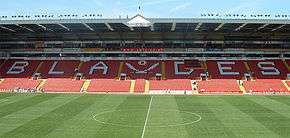 | |
| Location | Bramall Lane, Sheffield, South Yorkshire, England S2 4SU |
|---|---|
| Coordinates | 53°22′13″N 1°28′15″W / 53.37028°N 1.47083°WCoordinates: 53°22′13″N 1°28′15″W / 53.37028°N 1.47083°W |
| Owner | Sheffield United |
| Capacity | 32,702[1] |
| Field size |
112 x 72 yards (pitch) 258 x 267 yards (full site, see map) |
| Surface | Desso GrassMaster |
| Construction | |
| Broke ground | 1855 |
| Opened | 30 April 1855 |
| Renovated |
1966 (Bramall Lane Stand Built) 1975 (South Stand built) 1991 (Kop Seated) 1994 (all-seated) 1996 (John St. Stand rebuilt) 2006 (concourses in Bramall Lane Stand redeveloped) |
| Expanded |
2001 (Kop Corner built) 2006 (Westfield Health Stand built) |
| Architect | (John St Stand) Ward McHugh Associates |
| Tenants | |
|
1855–1893 Yorkshire CCC (played until 1975) 1889–present Sheffield United F.C. | |
Bramall Lane is a football stadium in Sheffield, South Yorkshire, England. It is the home of Sheffield United. As the largest stadium in Sheffield during the 19th century it hosted most of the city's most significant matches including the final of the world's first football tournament, first floodlit match and several matches between the Sheffield and London Football Associations that led to the unification of their respective rules. It was also used by Sheffield Wednesday and Sheffield F.C. for major matches. It has been the home of Sheffield United since the club's establishment in 1889. It is the oldest major stadium in the world still to be hosting professional association football matches.[2][3]
The stadium was built on a Sheffield road named after the Bramall family (who were file and graver manufacturers). The Bramalls owned "The Old White House" on the corner of Bramall Lane and Cherry Street, and subsequently built the Sheaf House, now a public house that still stands at the top of Bramall Lane. The stadium was originally opened as a cricket ground. It was also used for football games in the 19th century by Sheffield F.C. and Sheffield Wednesday but since 1889 it has been the home of Sheffield United.
Bramall Lane is one of only two grounds (the other being the Oval) which has hosted England football internationals (five games prior to 1930), an England cricket test match (a single Test, in 1902, against Australia) and an FA Cup Final (the 1912 replay, in which Barnsley beat West Bromwich Albion, 1–0). It also regularly hosted FA Cup Semi Finals and replays between 1889 and 1938.
The ground has also hosted rugby league games for the Sheffield Eagles,[4] a Billy Graham Evangelist meeting in 1985 and a pair of rock concerts by Bruce Springsteen in 1988.
The record attendance for the ground is 68,287, set at an FA Cup 5th Round tie between Sheffield United and Leeds United on 15 February 1936. The ground has now been extensively renovated in the wake of the Taylor Report, and has an all-seated capacity of 32,702,[1] making it the largest capacity ground outside the top two tiers of the English football league system.
History
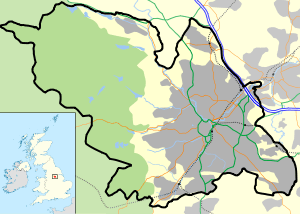
Cricket at the Lane

Bramall Lane opened as a cricket ground in 1855, having been leased by Michael Ellison from the Duke of Norfolk at an annual rent of £70. The site was then away from the city's industrial area, and relatively free from smoke. It was built to host the matches of local cricket clubs and originally had six clubs playing there, one of whom was the Wednesday Cricket Club, forerunner of Sheffield Wednesday.
Bramall Lane opened on 30 April 1855 as a cricket ground with a match between "The Eleven" and "The Twenty Two",[3] The Eleven, despite being the senior team, lost by an innings and 28 runs.
A team representing Yorkshire played the first county match at the ground on 27 August 1855, against Sussex but lost by an innings and 117 runs.[5]
Although the first county game had been played eight years earlier, the official Yorkshire County Cricket Club was not formed until 1863.[6] The idea came from Ellison, who was using his own finances to support the club, in order to improve Bramall Lane's financial position as the county's headquarters. It was the club's headquarters until 1893, when they moved to Headingley in Leeds.[6]
In 1897, Jack Brown and John Tunnicliffe recorded a first wicket score of 378 against Sussex—a ground record that has never been beaten. Brown's score of 311 and Yorkshire's innings of 681 for 5 declared were also records when the cricket ground closed.[7] Other notable scores include the 582 for 7 declared they piled up against Surrey in 1935 and the 579 posted against the touring South Africans in 1951. Six other scores in excess of 500 were made. In contrast there were a host of scores under 100, mainly in the 19th century, although Derbyshire's paltry total of 20 in 1939 remains the lowest ever score. Nottinghamshire were dismissed for 24 in 1888 but Kent showed the Yorkshire batsmen up in 1865, bowling them out for 30. Many of the low totals were made on rain affected, uncovered wickets.
The ground hosted a single Test match in 1902, against Australia, which England lost by 143 runs.[8] Australia won thanks to a century by Clem Hill and the bowling of Saunders and Noble, who each took 5 wickets in England's first innings of 145 and Noble and Trumble who took 6 and 4 wickets respectively to bowl the home team out for 195 second time around. The defeat was blamed on the poor light at the ground; a product of smoke emitted by local factories. Attendances were poor, and the experiment was never repeated.
In addition Jack Brown's triple century 10 double centuries were scored on the ground, Sir Len Hutton scored unbeaten two double tons, an 280* against Hampshire in 1939 and 271* against Derbyshire in 1937. W Barber posted 255 against Surrey in 1935 while the great Indian batsman V.S. Hazare scored 244 not out for the Indian tourists in the first season after World War II.
Among many notable partnerships W. Barber and Maurice Leyland amassed 346 for the second wicket against Middlesex in 1932 and the aforementioned V.S. Hazare and Vinoo Mankad put on 322 for the Indians against Yorkshire for the 4th wicket in 1946. Only one century was scored in list A one-day cricket at Bramall Lane, John Hampshire's 108 against Nottinghamshire in 1970 in the Sunday League.
Three bowlers took all ten wickets in an innings at Bramall Lane, the feat being more common in the annals of first class cricket than many imagine. The great Australian leg spinner Clarrie Grimmett took 10 for 37 for the tourists in 1930 while TF Smailes took all 10 for 47 for Yorkshire against Derbyshire in 1939. G. Wootton took 10 for 54 for an All England Eleven v Yorkshire in 1865 while 9 other bowlers took 9 wickets in an innings there, including a haul of 9 for 12 by the great Yorkshire slow left armer Hedley Verity.
The best match bowling figures at the ground, 16 for 114, were recorded by G. Burton of Middlesex against Yorkshire in 1888 while Hedley Verity took a remarkable 15 for 38 against Kent in 1936. Len Braund took 15 for 71 for Somerset in 1902 while W. G. Grace showed his youthful talent with the ball with a haul of 15 for 79 for Gloucestershire in 1872.
D. Hunter of Surrey dismissed caught 5 batsmen and stumped another in one innings in 1891 while Yorkshire stalwart Jimmy Binks completed 5 dismissals in an innings 3 times.
The two ends of the ground were known as the Pavilion End and the Football Ground End. Between 1863 and 1973, Yorkshire played 391 first class matches, including 339 County Championship matches at Bramall Lane. Yorkshire's last match at the ground took place on 4, 6 and 7 August 1973, a drawn game against Lancashire.[6] The construction of the South Stand began soon after, over the cricket square, finally enclosing the football pitch on all four sides.[9] Yorkshire's cricket games in Sheffield moved to Abbeydale Park.
Football at the Lane
The ground hosted its first football match on 29 December 1862,[3] between Sheffield F.C. and Hallam F.C. The game was played to raise money for the Lancashire Distress Fund and ended 0–0.
As Sheffield's main sporting stadium it held all the most important local matches. The world's first football tournament, the Youdan Cup, held its final at Bramall Lane in March 1867 with Hallam beating Norfolk.[10] This was followed by the Cromwell Cup a year later, which was won by a newly formed team called The Wednesday.[11] By 1877, a crowd of 8,000 watched The Wednesday beat Hallam in the Sheffield Challenge Cup.[12] Bramall Lane effectively became The Wednesday's permanent home between 1880 and the opening of their new stadium at Olive Grove in 1887.[13]
The first inter-association match, between the FA (often referred to as the London FA) and Sheffield FA, was also held at Bramall Lane on 2 December 1871.[14] It was won, 3–1, by the home side, who also arranged a number of games with other Associations including regular fixtures against Glasgow.
On 22 March 1889, six days after 22,688 people paid to watch the FA Cup semi-final between Preston North End and West Bromwich Albion,[15] it was decided to create a home football team to play at Bramall Lane. It was named Sheffield United after the cricket team.
International matches
Bramall Lane was regularly used for international matches before the construction of a national stadium in London. The world's first ever floodlit football match took place at Bramall Lane on 14 October 1878 in front of an attendance of 20,000.[16] England's match against Scotland on 10 March 1883 was the first match between these two countries outside London or Glasgow. It makes it the oldest football venue still capable of hosting international matches in the world.
| Date | Result | Competition | ||
|---|---|---|---|---|
| 4 October 1883 | | 2–3 | | Friendly |
| 5 February 1887 | | 7–0 | | British Home Championship |
| 29 April 1889 | | 4–0 | | British Home Championship |
| 4 April 1903 | | 1–2 | | British Home Championship |
| 20 October 1930 | | 5–1 | | British Home Championship |
Milestones

- 1855: The ground at Bramall Lane built for cricket.
- 1878: First floodlit game played between "Reds" and "Blues" (the first competitive floodlit game was held at Mansfield Town's Field Mill ground).
- 1896: A new John Street Stand built with room for 6,000 both seated and standing.
- 1897: A new Shoreham Street Stand built.
- 1900: A new cricket pavilion built.
- 1901: Cycle track removed.
- 1911: Roof added to the Bramall Lane End.
- 1935: Roof added to the Kop. Running track built in front of John Street Stand.
- 1940: The ground damaged in Sheffield Blitz. John Street was badly affected and the Kop roof damaged.
- 1953: Floodlights installed.
- 1966: Bramall Lane Stand opened.
- 1975: South Stand opened.
- 1981: Cricket pavilion demolished.
- 1991: Seats installed in Kop.
- 1994: John Street demolished. Seats added to lower tier of Bramall Lane End.
- 1995: New pylon-less floodlights installed.
- 1996: New John Street Stand opened.
- 2001: New corner stand holding 1,000 fans opened between Shoreham Street and John Street.
- 2002: Blades Enterprise Centre is built between John Street and Bramall Lane.
- 2005: Wooden seats removed from South Stand.
- 2006: New corner opens between Cherry Street and Bramall Lane. Bramall Lane end cantilevered.
- 2008 : New hotel built on the corner of the south stand and Bramall lane end.
The ground today
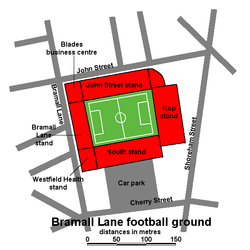
The stands
The ground has been an all-seater stadium since 1994 and is now made up of four main stands and two corner infill stands in the north-east and south-west corners.[17] The north-west corner (as well as a lot of the land under the John Street Stand) contains the Blades Enterprise Centre, and the south-east corner is still open, although there are plans to fill it with seating as part of the strategy to build a leisure complex at the back of the South Stand.
Redbrik Estate Agency Stand

Formerly the Bramall Lane stand, and sponsored by 188 Bet, this is the oldest existing stand at Bramall Lane, this two-tiered structure was opened in 1966 behind the goal at the Bramall Lane end, opposite the Kop. From the 2006–07 Premier League season, the bottom tier is occupied by away fans whilst the upper tier, which links into the south-west corner infill stand, is given to home fans (although part of the upper tier may be offered to away fans for cup fixtures if demand is sufficient). This is in contrast to previous seasons, when away fans had the upper tier (and hence the marginally better view) much to the annoyance of home fans. During the 2005–06 season, the outside of the Bramall Lane Stand was reclad in red-and-white, with the stand sponsors and the club crest on the outside of the stand, while the wooden seats of the upper tier were replaced with newer plastic seats with the words "BLADES" written into them. When the corner infill stand was built during the closed season, the roof over the Bramall Lane Stand was extended toward the pitch to provide better cover for the lower tier and to remove the supporting pillars from the upper tier. There are approximately 2,700 seats in the upper tier, and 2,990 in the lower, giving a total capacity of 5,680. This stand has for many years housed a basic LCD scoreboard and clock between the upper and lower tiers, however at the start of the 2006–07 season both were replaced by a modern colour video scoreboard. In 2012, the club announced that the stand would be named after Olympic Champion and United fan Jessica Ennis (now known as Jessica Ennis-Hill).[18]
In November 2014, Ennis-Hill stated a request to have her name removed from the stand if the club offered Ched Evans (a former United player wrongly convicted of rape) a contract.[19] Due to this, and other objections, he was not offered a contract. Ahead of the 2015–16 season, the stand was renamed after local company Redbrik Estate Agency on a three-year contract.[20] In October 2016 the charges against Evans were dropped, he was found not guilty of the offence and he restarted his playing career at Chesterfield F.C.[21]
The South Stand
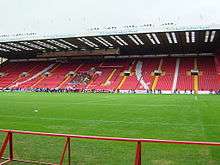
The South Stand is also known as the "Main Stand", however some fans still refer to it as the "Laver Stand" (after the stand's long-term sponsors in the 1990s) or even the "New Stand" by many older fans since there was no stand on the South end of the pitch until 1975, where previously it was used as the cricket pitch's outfield. Opened in August 1975, the South Stand is situated alongside the pitch and is for home fans who wish to have a side-view when watching the match (the John Street Stand is for families only). During the 2005–06 season, this stand was renovated, with a re-clad of the outside of the stand and the old wooden seats replaced by newer plastic seats forming an emblem of two swords written. The box-seats were also upgraded, and since the stand then has been under three different sponsorship deals (currently GAC Logistics). This stand holds approximately 7,500 fans, and most of the ground's amenities, including the box office, newly expanded and renovated for the 2006–07 season Blades Superstore, Platinum Suite, "Legends of the Lane" museum, "1889" award winning restaurant (formerly known as Bosworth's of Bramall Lane), the former police control centre (now relocated to the Blades Enterprise Centre between the Bramall Lane and John Street Stands), newly refurbished reception, press box, players entrance, administrative offices and television gantry attached to the roof of the stand. The bottom of the stand, facing into the club car park, has been made into a fans "Wall of Fame". Built of the ground's signature mark red bricks, each one is etched with an individual supporters' name or nickname. The wall was launched as a commercial venture by the club in the 1990s and is still offered today for other sections of the ground.[22]
The Kop Stand

Seated since 1991, this is the area in which the most boisterous home fans sit,[23] such that former assistant manager (1999–2003) and manager (2008–10) Kevin Blackwell named the noise coming from this stand as the "Bramall Roar" after the 2003 play-off semi-final second-leg against Nottingham Forest, which the Blades won 4–3, coming from 0–2 down.[24] The stand is currently sponsored by Kennedy's Law and, was formerly sponsored by Hallam FM. The stand itself is built into a hillside situated behind the goal, at the east end of the stadium. This places the stand along Shoreham Street, hence the often-heard chant of "Hello! Hello! We are the Shoreham Boys" coming from this stand on matchdays.[25] It has the club's initials "SUFC" written into the seats, and holds 10,221 fans, making this the largest stand at Bramall Lane. The facilities are of lower quality in the Kop because there is no indoor concourse, although an outdoor bar was completed in September 2007 to complement the fast-food takeaway, but in spite of this it is still a firm favourite amongst the fans, and usually full on matchday. At a Shareholders' meeting in November 2007 the club announced that it intended to expand the Kop by 3,500 (making it the largest 'kop' in the country) and to upgrade all the facilities and cover the concourse areas.[26] However, since then, former chief executive Trevor Birch announced that the extension will not be taken into consideration until the club can gain and maintain Premier League status. United submitted a revised application for the redevelopment of the stand in 2015, which would see 3,215 seats added to its current capacity.[27]
John Street Stand

The John Street stand, completed in 1996, is used as a family enclosure for home fans and is situated along the north side of the pitch, boasting great views of the playing action. Sponsored by the Maltese Tourist Board, in a combined stand and shirt sponsorship deal, it has the word "BLADES" written in the seats, and holds just under 7,000 fans. This is also where the home disabled supporters may sit. The stand is home to a small club shop as well as the Marstons & Malta Executive Suites and "Tunnel Bar". There is also a row of 31, individual executive boxes with private facilities and their own balconies along the back of the stand.
Kop Corner
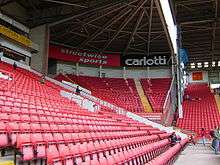
Also called the Northeast Corner or Pukka Pies Stand after its sponsorship deal, this stand was completed in 2001 and is between the Kop and the John Street stand. It is fully linked to the John Street Stand, and is also used as a family enclosure holding around 900 fans (after the installation of new restricted-view seats after the 2006–07 campaign. This section of the ground has always been part of the Kop stand structure and the lower half was historically used as a family standing enclosure until it was demolished as part of the main Kop re-development.
Westfield Health Stand
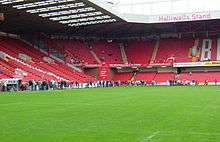
Also known as the "new" corner infill, this stand is in the south-west corner of the stadium, between the Bramall Lane Stand and the South Stand and is sponsored by Westfield Health. It is linked to the Bramall Lane stand (upper tier), sharing its facilities, turnstiles and exits. It is always used by home fans, and reputedly has the best views of the ground, although season tickets are not available in this stand. The stand holds approximately 2,000 fans.
Blades Enterprise Centre
The north-west corner is filled in by rentable offices, known as the Blades Enterprise Centre, one of many examples of United diversifying their off-the-field activities to maximise income streams. The Enterprise centre provides office space for smaller and new companies in the block between the John Street and Bramall Lane stands, and also underneath the John Street stand itself. Built in 2002, the club intend to build another much larger business centre in between the Kop stand and South stands with work to begin during the Summer 2008. However this has been delayed.
Current and ongoing work
The stadium has an enviable central location close to the city centre. In order to maximise the earnings potential of the land around the stadium in June 2007 work began to build a 158 bedroomed 4 star Millennium and Copthorne Hotel behind the new Westfield stand. The new hotel opened its doors in November 2008.
At the Shareholders' meeting in November 2007 the club announced that it intends to extend the back of the Kop stand with an additional 3,200 seats and remove the pillars holding up the roof. As the revised stand capacity is likely to be about 13,400, it will overtake Anfield to become the largest single tiered Kop stand in British football.
The club also plan a major upgrade to the Kop facilities and covering of the concourse areas. The club is conscious of creating non football related income streams therefore they also plan to build student accommodation at the back of the Kop and a large business centre (office block) between the Kop and South stand. A planning application is to be submitted in October 2008 with work scheduled to begin towards the end of the 2008–09 season. However this has been delayed.
In the same meeting the club announced that its long term ambitions are to add an additional 6,000 seats to the main South (Valad) Stand with the intentions of taking the overall stadium capacity to just over 44,000, however this expansion would depend on demand in the Premiership and any potential 2018 World Cup venue bid. United PLC Chairman Kevin McCabe has stated that he would build Bramall Lane's extensions to any specifications laid down by the FA with a view to the ground hosting matches should England be successful in winning their World Cup bid.[28] However, on 16 December 2009, the FA announced that Hillsborough Stadium (home of rivals Sheffield Wednesday) would be Sheffield's venue in the event that a World Cup is awarded to England and Sheffield is named a host city.[29] Following this announcement Sheffield United's Chief Executive, Trevor Birch, made it known that all planned redevelopment work had been put on hold until the club was able to regain and maintain Premiership status. With Sheffield United's relegation to League One in May 2011 any further redevelopment work would seem unlikely in the near future.
In May 2015 work began on the installation of a state-of-the-art Desso pitch, bringing to an end around 153 years of football being played on a traditional surface at the oldest professional football stadium in the world. The Desso GrassMaster surface is used at top level venues across Europe such as Wembley, Stamford Bridge, Old Trafford and San Siro.[30]
Attendance

The record attendance stands at 68,287 for the Sheffield United v Leeds United F.A. Cup fifth round tie, played on 15 February 1936.
The record attendance since the 1994 introduction of all spectators being seated is 32,604 at the Sheffield United v Wigan Athletic game in the Premier League, on 13 May 2007.[31]
Average league attendances
- This is the average league attendances stretching back over ten years for Sheffield United home matches at Bramall Lane. Sheffield United away games and any home cup matches are excluded. For more details on this topic, see Sheffield United F.C. seasons.
- 2005–2006: 23,650
- 2006–2007: 30,684[32]
- 2007–2008: 25,631[33]
- 2008–2009: 26,023
- 2009–2010: 25,120
- 2010–2011: 20,632
- 2011–2012: 18,702[34]
- 2012–2013: 18,612[35]
- 2013–2014: 17,507[36]
- 2014–2015: 19,805[37]
- In season 2007–2008, Sheffield United had the best average attendance in the Coca Cola Championship.
- In the 2008–2009 season Sheffield United had the second best average attendance of 26,023 in the Coca Cola Championship.
Transport
Sheffield railway station is just under a mile from Bramall Lane ground.[38]
The Supertram also runs less than a mile from the ground, the nearest stop is at Granville Road/Sheffield College.
There are also bus links outside the ground, with buses at least every 5 minutes during the daytime going to/from the city centre.
See also
Further reading
- Chris Arnot, Britain's Lost Cricket Grounds, Aurum, 2011.
References
- 1 2 Adams, Duncan. "Football Ground Guide: Bramall Lane". footballgroundguide.co.uk. Archived from the original on 11 July 2011. Retrieved 1 February 2009.
- ↑ "Match report". BBC. 2 August 2013. Retrieved 2 August 2013.
- 1 2 3
- ↑ "Sheffield Eagles Club History". Sheffield Eagles RLFC. Archived from the original on 15 October 2006. Retrieved 10 January 2007.
- ↑ Rose, Graham. "Yorkshire v Sussex, Bramall Lane, Sheffield". Cricinfo. Retrieved 30 November 2006.
- 1 2 3 Hodgson, Derek (March 2006). "Yorkshire County Cricket Club: A Short History".
- ↑ 150 Years of Bramall Lane by Peter Goodman and Steve Hutton ISBN 0-901100-63-3
- ↑ "England v Australia at Sheffield". CricInfo England. Retrieved 24 November 2006.
- ↑ Cricinfo
- ↑ Pauron, Frédéric. "Tommy Youdan Cup 1867". Retrieved 30 November 2006.
- ↑ "Cromwell Cup". 15 February 1868. Archived from the original on 5 June 2012. Retrieved 30 November 2006.
- ↑ "Sir Charles Clegg". Retrieved 30 November 2006.
- ↑ "Bramall Lane". Retrieved 8 January 2008.
- ↑ Young, Percy A. (1962). Football in Sheffield. S. Paul.
- ↑ "History of Sheffield United". www.sufc.co.uk. See "Early football at Bramall Lane"
- ↑ Farnworth, Keith (1983). Wednesday!. Sheffield City Libraries. ISBN 0-900660-87-2.
- ↑ "Ground plan". Sheffield United F.C. Retrieved 27 September 2007.
- ↑ "Jessica Ennis to have Sheffield United stand named after her". BBC News. 31 August 2012. Retrieved 31 August 2012.
- ↑ "Ched Evans: Jessica Ennis-Hill makes Sheffield United warning". BBC News. 13 November 2014.
- ↑ "Sheffield United rename Jessica Ennis-Hill stand after sponsor". BBC Sport. 16 June 2015. Retrieved 16 June 2015.
- ↑ "Ched Evans: Footballer found not guilty of hotel rape". BBC News. 14 October 2016. Retrieved 29 November 2016.
- ↑ "The brick wall at Bramall Lane (home to Sheffield United FC)". Flickr.
- ↑ Aitken, Sean. "Bramall Lane". Swinton Blades.
- ↑ "A Guide to Bramall Lane". Archived from the original on 3 February 2004. Retrieved 2 December 2006.see "The Kop sponsored by Hallam FM"
- ↑ Adams, Duncan. "Football Grounds Guide". Retrieved 2 December 2006. See "What do the Sheffield United fans sing?"
- ↑ "Blades stadium designs". Retrieved 4 December 2007.see "The Kop Stand"
- ↑ https://www.insidermedia.com/insider/yorkshire/blades-to-kickstart-bramall-lane-redevelopment
- ↑ Shield, James. "Blades' World Cup bid". Sheffield Star (Johnston Press Group PLC).
- ↑ The Football Association. "The website for the English football association, The FA Cup and The England football team – England – The FA".
- ↑ http://www.sufc.co.uk/news/article/sheffield-united-desson-grassmaster-bramall-lane-2453725.aspx
- ↑ "League Attendances from sufc.co.uk". www.sufc.co.uk. 2006. Retrieved 2 December 2006.
- ↑ "League Attendances from sufc.co.uk". www.sufc.co.uk. 2007. Retrieved 14 May 2007.
- ↑ "Division Attendance – Football League – Status".
- ↑ "2011–2012 Average League Attendance from worldfootball.net". www.worldfootball.net. 2015. Retrieved 27 July 2015.
- ↑ "2012–2013 Average League Attendance from worldfootball.net". www.worldfootball.net. 2015. Retrieved 27 July 2015.
- ↑ "2013–2014 Average League Attendance from worldfootball.net". www.worldfootball.net. 2015. Retrieved 27 July 2015.
- ↑ "2014–2015 Average League Attendance from worldfootball.net". www.worldfootball.net. 2015. Retrieved 27 July 2015.
- ↑ "Archived copy". Archived from the original on 5 November 2010. Retrieved 2010-11-02.
External links
| Wikimedia Commons has media related to Bramall Lane. |
- Visitors' Guide to Bramall Lane from Sheffield United official website
- when Bramall Lane was a first-class Cricket Ground from CricInfo
- Stadium pictures